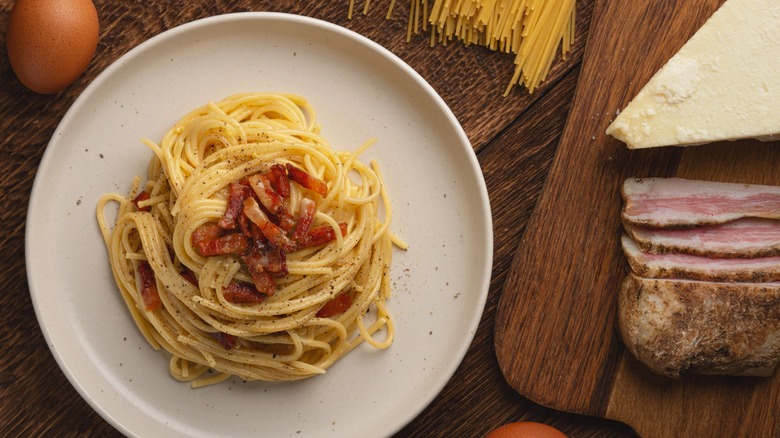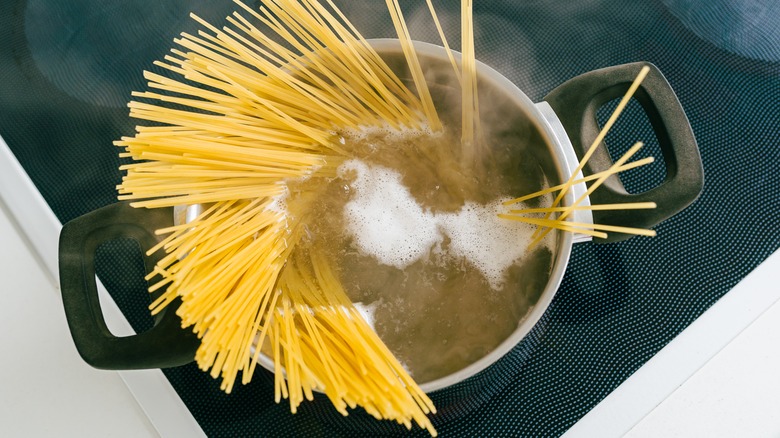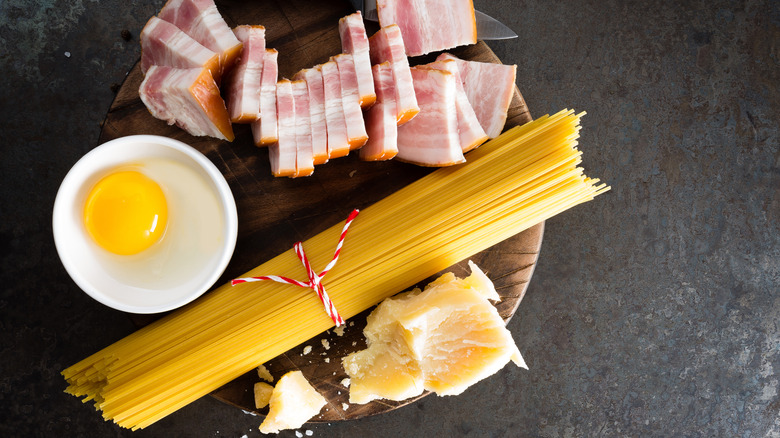Timing Is Everything When It Comes To Making The Best Carbonara
Spaghetti carbonara is one of those pasta dishes that's so famous, so simple, and yet so easy to get wrong. Carbonara traditionally consists of only a few ingredients: spaghetti, egg yolk, Pecorino Romano cheese, guanciale, and black pepper. They ingredients are simple, so it makes sense that the magic of a good carbonara is not just in what is being cooked, but how it is cooked. And the secret to that is all in the timing.
The best carbonara is made quickly, so get all your ingredients ready and make sure you remember the basic sequence of events before you start cooking. Then, there are two vital timing rules to know if you're making carbonara. First, because you're going to continue cooking your pasta in another pan after you remove it from the boiling water, it's important to remove it from the water 2 minutes sooner than you would if you were serving it immediately. And secondly, above all else, always take your pasta off the heat before adding the egg and cheese. Everyone who cooks carbonara has forgotten about this at least once and ended up with spaghetti with scrambled eggs and oily, separated cheese. Not a pretty sight.
More secrets to perfectly timing your carbonara
Whether you're buying pasta from the store or making your own pasta dough at home, every variety has a different cooking time. Spaghetti is the most common choice for traditional carbonara, but there isn't a rule here. Choose the pasta you like the most, and adjust your timing to make the sauce around how long the spaghetti needs to boil for your preferred texture. Generally, for a carbonara, it shouldn't take much longer than the time needed to boil water and cook the pasta, plus a minute or two to plate.
Another tip: Simply scoop a measuring jug's worth of pasta water from your spaghetti, then drain it into a colander straight over the sink as usual, and return the pasta to the pot. It's quicker than finding (and washing) a separate pan. And a final note on timing: Like salt, there are some ingredients that you can easily add to a sauce, but can't easily remove. Eggs and cheese are two examples, so to avoid the risk of ending up with a runny carbonara sauce in the final moments, add your egg and pecorino mix to your pasta bit by bit, stirring all the while, until you get the consistency just right.
The best ingredients for true carbonara
Not everyone has the same definition of what's best about a dish, but when it comes to much of Italian cooking, there are well-established cultural understandings of how many recipes should be prepared and how they should taste.
To make a proper carbonara, you must use guanciale. Although you can make something similar (but untraditional) using bacon or another kind of cured meat, guanciale has a particularly salty, porky flavor that's hard to replicated. Another nontraditional addition to carbonara is cream — again, you could do this with delicious results, but the sauce won't be the real deal.
If you want to go above and beyond and try to make the best carbonara possible, you've got to get the best ingredients. Parmesan is the superstar of Italian cheeses and a real umami bomb, but a perfect carbonara calls for Pecorino Romano, which is both creamier and saltier. The eggs matter too: For maximum richness, you want to use mostly yolks. Save the leftover egg whites and use them to make egg white muffins or meringues. The ideal yolks are a deep orange, as they create a beautifully appetizing color in the finished carbonara.


